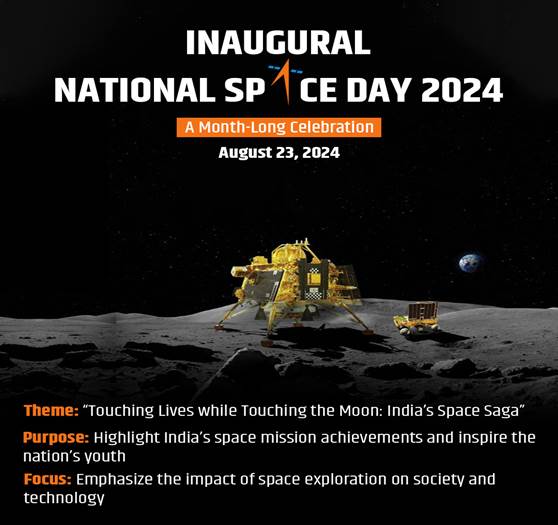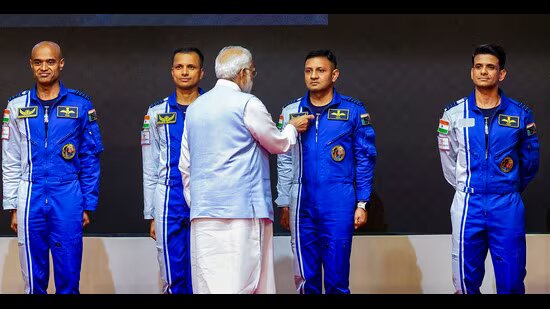National Space Day commemorates the groundbreaking success of the Chandrayaan-3 mission, which achieved the safe landing of the Vikram Lander on the lunar surface on August 23, 2023. With this achievement, India proudly became the fourth country to successfully land on the moon, making history as the first to land near the southern polar region. India’s first National Space Day theme is “Touching Lives while Touching the Moon: India’s Space Saga.”

The propulsion module carried the lander and rover configuration to a 100 km lunar orbit. The propulsion module had a Spectro-polarimetry of Habitable Planet Earth (SHAPE) payload to study the spectral and Polari metric measurements of Earth from the lunar orbit.
According to Indian Space Research Organisation (ISRO), the Chandrayaan-3 mission’s three objectives were to demonstrate a safe and soft landing on the lunar surface, to demonstrate a Rover roving on the Moon and to conduct in-situ scientific experiments.
Characteristics of Chandrayaan-3
Chandrayaan-3 consisted of an Indigenous Lander module (LM), Propulsion module (PM) and a Rover to develop and demonstrate new technologies required for Interplanetary missions.
Payloads of Chandrayaan-3 and their objectives
Lander Payloads
1. Chandra’s Surface Thermophysical Experiment (ChaSTE): To measure the thermal properties of lunar surface near polar region.
2. Instrument for Lunar Seismic Activity (ILSA): For measuring the seismicity around the landing site and delineating the structure of the lunar crust and mantle.
Story continues below this ad
3. Radio Anatomy of Moon Bound Hypersensitive ionosphere and Atmosphere (RAMBHA): To estimate the plasma density and its variations.
4. Laser Retroreflector Array (LRA): A passive experiment to understand the dynamics of Moon system.

Rover Payloads
1. Alpha Particle X-ray Spectrometer (APXS): To determine the elemental composition of Lunar soil and rocks around the lunar landing site.
2. Laser-Induced Breakdown Spectroscope (LIBS): For deriving the elemental composition in the vicinity of the landing site.
Propulsion Module Payload
Story continues below this ad
Spectro-polarimetry of HAbitable Planet Earth (SHAPE): Future discoveries of smaller planets in reflected light would allow us to probe into a variety of Exo-planets that would qualify for habitability (or for presence of life).
Significance of Chandrayaan-3 Mission
The success of the Chandrayaan-3 mission is of great significance to India, as it established India’s reputation as a serious player in planetary exploration. It consolidated India’s position as a space power.
Compared to other countries, India has a comparatively low-budget aero-space programme. But the efficiency and cost-effectiveness with which ISRO carries out its projects have helped in building a formidable brand name for the space agency. Chandrayaan-3 was accomplished at a cost of Rs 615 crore (a fraction of the cost of an Airbus).
Amitabh Sinha writes—
“It is a landmark event, no doubt. But if you look beyond the event, it gives us a very important capability. It gives us physical access to another planetary body. The fact that we are only among a handful of countries with this capability means we are at the forefront of this technology. And therefore, we will be part of all decision-making related to future planetary explorations and even extraction of resources from space. We are naturally part of the club that formulates these policies.
Story continues below this ad
Space capabilities will occupy a central place in deciding the equations between countries in the 21st century, and the influence they have in the international community. The important thing is that we should be able to participate and contribute on equal terms. And we should be able to play a more decisive role in space-related international decision-making processes. Chandrayaan-3 gives us that confidence and capability.”
Findings of Chandrayaan-3 Mission
After one year since Chandrayaan-3 landed on the lunar surface, Indian scientists have revealed the findings from studies carried out by one of the rover module’s instruments.
Sohini Ghosh writes—
“The findings comprise the first analysis of the composition of the topsoil in the Moon’s southern latitudes, and support the widely-accepted hypothesis that the lunar surface in the immediate aftermath of the Moon’s formation was covered by a sea of molten material.
The data collected by the Alpha Particle X-ray Spectrometer (APXS) also contain new information about the elemental composition of the lunar surface that can help to better understand the evolution of the Moon. The findings were published in the journal Nature on Wednesday. Scientists have reported three key findings.
Story continues below this ad
1. The terrain around Chandrayaan 3’s landing sight is fairly uniform;
2. The Moon’s crust was formed layer by layer, which adds weight to the lunar magma ocean (LMO) hypothesis; and
3. The topsoil around the lunar south pole has a greater-than-expected sprinkling of minerals which compose the lower layers of the lunar crust.”
What are the Chandrayaan missions?
India’s Chandrayaan missions are aimed at lunar exploration.
Chandrayaan-1
Story continues below this ad
Launched on October 22, 2008, Chandrayaan-1 was India’s first Lunar mission that took off from the Satish Dhawan Space Centre SHAR, Sriharikota in Andhra Pradesh. The Chandrayaan-1 gave a major fillip to the Indian space program as it was the country’s indigenously developed technology to explore the Moon.
A huge victory was achieved on November 14, 2008, when the MIP (Moon Impact Probe) was separated and it struck the lunar South Pole in a controlled manner. And with that, India became the fourth country in the world to hoist its national flag on the lunar surface. Chandrayaan-1’s biggest discovery was to find traces of water on the Moon, which was in itself a path-breaking achievement in international space science. This discovery gave the ISRO renewed interest in pursuing the Chandrayaan-2 for the mission to Moon. Besides this, the spacecraft also found water ice in the North polar region of the Moon as well as detected Magnesium, Aluminium and Silicon on its surface.
Chandrayaan-2
Chandrayaan-2 consisted of an Orbiter (to orbit the planetary body), a Lander (intended to land on the Moon’s surface), and a Rover (designed to move on the Moon’s surface). The mission aimed to explore the south pole of the Moon. Launched in July 2019, the mission was only partially successful, as its lander, Vikram, and rover, Pragyaan, crashed on the Moon’s surface on September 7 of the same year.
Story continues below this ad
Chandrayaan-4
The designs of India’s next mission to the Moon, Chandrayaan-4 — which will bring rock and soil samples back to the Earth — has been finalised, and will most likely happen in 2027, said ISRO chairman S Somanath said on the occasion of National Space Day.
After a successful moonshot, ISRO aimed for the Sun Through Aditya-L1
It was launched with the mission of observing and helping us better understand the Sun. Aditya-L1 is placed outside of the Earth’s atmosphere, and its instruments can study ultraviolet radiation from the corona, allowing scientists to better understand how it works. Aditya-L1 consists of seven instruments to observe all radiation and charged particles. Its location is 1.5 million kilometres away from Earth, towards the Sun.
ISRO’s Next Goal: Gaganyaan
Announced in 2018, Gaganyaan is one of India’s most ambitious space programmes. Gaganyaan project aims to demonstrate human spaceflight capability by sending a crew of 3 members to a 400 km orbit for a 3-day mission and safely returning them to Earth by landing in the Indian sea waters. Just three countries – the United States, Russia and China – have executed human spaceflight missions till now.
The task of sending humans into the vast unknown and bringing them back safely is more expensive and challenging than the Mars and Moon missions. A successful execution would put India in the company of the US, Russia and China.
Story continues below this ad
As stated on the ISRO website, the short-term goal of Gaganyaan is to demonstrate human spaceflight to Low Earth Orbit, while the long-term goal is to lay the foundation for a “sustained Indian human space exploration programme”. Success in its ultimate objective — proving that India is capable of indigenously developing this complex technology — would be a huge boost for ISRO.
 Prime Minister Narendra Modi hands over wings to astronauts-designate Shubanshu Shukla, Prashanth Balakrishnan Nair, Angad Prathap and Ajit Krishnan who have been selected to be the astronauts on India’s first crewed mission to space ‘Gaganyaan Mission’, at the Vikram Sarabhai Space Centre (VSSC), in Thiruvananthapuram. (PTI Photo)
Prime Minister Narendra Modi hands over wings to astronauts-designate Shubanshu Shukla, Prashanth Balakrishnan Nair, Angad Prathap and Ajit Krishnan who have been selected to be the astronauts on India’s first crewed mission to space ‘Gaganyaan Mission’, at the Vikram Sarabhai Space Centre (VSSC), in Thiruvananthapuram. (PTI Photo)
The Gaganyaan mission is scheduled for next year. But before that two uncrewed preparatory missions, Gaganyaan-1 (G1) and Gaganyaan-2 (G2), would be flown, the first one later this year.
G1, scheduled for launch in December, will mainly test the safe re-entry of the spacecraft and its orientation upon its dive into the sea. The G2 mission will carry Vyommitra inside the human-rated pressurised crew module, where the astronauts would be seated in the actual flight. The robot will be tasked with recording all parameters that will be used to study the impacts of the flight on humans.
In February this year, Prime Minister Narendra Modi had introduced the four Indian Air Force pilots — Group Captain Prasanth Balakrishnan Nair, Group Captain Ajit Krishnan, Group Captain Angad Pratap and Wing Commander Shubhanshu Shukla — selected for the Gaganyaan mission who have been undergoing training for the last few years.
POST READ QUESTIONS
(1) With reference to the following lines, answer the question below:
It is India’s heaviest rocket, with a gross lift-off weight of 640 tonnes, an overall length of 43.5m and 5m-diameter payload fairing (nose-shaped equipment to protect the rocket from aerodynamic forces). It made its first journey into space in 2014 and also carried the Chandrayaan-2 in 2019. Most recently, in March this year, it placed 36 OneWeb satellites, weighing about 6,000kg, in LEO, showing its capabilities to deliver multiple satellites into space. This was the second time that it made a commercial launch — the first one came in October 2022 when it delivered the OneWeb India-1 mission.
It refers to:
(a) LVM3
(b) GSLV
(c) PSLV
(d) None of the above
(2) With reference to the LVM-3, consider the following statements:
1. It is capable of placing the 4 tonne class satellites of the GSAT series into Geosynchronous Transfer Orbits.
2. It is a two stage launch vehicle.
3. It uses only solid propellant.
How many of the statements given above are correct?
(a) Only one
(b) Only two
(c) All three
(d) None
Mains
What is the significance of the Gaganyaan Mission? Discuss about the Test Vehicle Abort Mission-1 (TV-D1).
(Sources: isro.gov.in, Chandrayaan-1, What Chandrayaan-3 means for India as a space exploration player, Chandrayaan-3 Mission , What the first findings from ISRO’s Chandrayaan 3 mission tell us about the Moon,Important Space Mission)
For your queries and suggestions write at roshni.yadav@indianexpress.com
Subscribe to our UPSC newsletter and stay updated with the news cues from the past week.
Stay updated with the latest UPSC articles by joining our Telegram channel – Indian Express UPSC Hub, and follow us on Instagram and X.


 (Source: ISRO)
(Source: ISRO)

 Prime Minister Narendra Modi hands over wings to astronauts-designate Shubanshu Shukla, Prashanth Balakrishnan Nair, Angad Prathap and Ajit Krishnan who have been selected to be the astronauts on India’s first crewed mission to space ‘Gaganyaan Mission’, at the Vikram Sarabhai Space Centre (VSSC), in Thiruvananthapuram. (PTI Photo)
Prime Minister Narendra Modi hands over wings to astronauts-designate Shubanshu Shukla, Prashanth Balakrishnan Nair, Angad Prathap and Ajit Krishnan who have been selected to be the astronauts on India’s first crewed mission to space ‘Gaganyaan Mission’, at the Vikram Sarabhai Space Centre (VSSC), in Thiruvananthapuram. (PTI Photo)






























